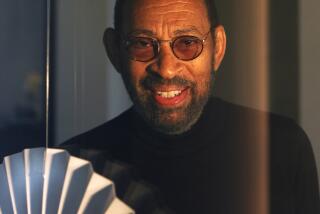A star whose glow was subtle
- Share via
He was never a major movie star. But when Gregory Hines appeared on screen, people were always glad to see him. This was especially true, of course, when he was dancing.
In his first movie role, as the Roman slave Josephus in Mel Brooks’ 1981 pastiche “History of the World, Part I,” Hines drops into a soft-shoe routine the same way anyone else falls onto a couch. There are near-delirious rapture and lightly worn defiance on Hines’ face as his sandaled feet rhythmically rearrange sand scattered atop an auction block.
In those few seconds, Hines made tap-dancing hip again, and if he’d done nothing more than that, the movies would be in his debt. He did do more, of course. But one wishes the movies could have done more for him in return.
Since Hines’ death earlier this month at age 57 from cancer, tributes have placed his dancing in the foreground. That’s as it should be. “The Cotton Club” (1984) and “White Nights” (1985) are considered his most significant movie roles, mostly for his flashy moves.
Indeed, whenever he revs up his terpsichorean equipment in front of the camera, Hines glows with the kind of magnetic confidence and strength of personality rivaled only by the great screen song-and-dance men of the 1930s, ‘40s and ‘50s. The excitement of watching Hines’ fabled tap duet with Mikhail Baryshnikov in “Nights” may now give way to grief over the fact that his movie career peaked at or close to the nadir of big-screen musicals. Maybe if he’d come along 20 or 30 years sooner.
And maybe, just maybe, if he’d been white.
The movies have never been good at knowing what to do with African American actors who are urbane, idiosyncratic and unconventionally good-looking. Hines was all of those, and not even immaculate timing and infectious warmth were enough to get him as many feature film roles as white actors of comparable gifts and looks.
In roles in which he wasn’t required to dance, Hines projected unerring grace and a supple humor that never capitulated to stereotype or overbearing “jivey-ness.” As a proto-hippie coroner in the underrated 1981 horror film “Wolfen,” Hines bounces off Albert Finney’s dour cop as if he were a handball and Finney were an asphalt surface. He provided comic relief on a level of sophistication higher than what had been expected from black actors in similar roles -- even at that (relatively) late date.
He had a similarly eccentric role in 1983’s “Deal of the Century,” in which he played a disillusioned weapons merchant who found a higher calling.
When he wasn’t dancing as Sandman Williams in “Cotton Club,” Hines seized whatever chances he could to pump some juice and depth into the role. But the movie lets him down.
The inevitable sidekick roles followed, the best being his pairing with Billy Crystal in 1986’s “Running Scared.” Even at the time, the movie went down like soup reheated too often.
For Hines’ devotees, “Tap” (1989) is a keeper for obvious reasons, offering one of the rare occasions when his acting and dancing are given equal opportunity to shine. But despite glowing notices for Hines’ performance, he eventually found television more hospitable to his individualistic persona, thus roughly aligning his career trajectory with generations of African American actors.
Still, there are two other nondancing Hines roles in feature films that merit attention. He was probably the best thing about the 1995 adaptation of “Waiting to Exhale,” in which he played a shy blue-collar guy. And then there’s 1998’s “The Tic Code,” in which Hines brought empathetic brio to his portrayal of a jazz saxophonist with Tourette’s syndrome.
That movie deserved better than it received. So, in the longer, wider view of things, did its star.
More to Read
Only good movies
Get the Indie Focus newsletter, Mark Olsen's weekly guide to the world of cinema.
You may occasionally receive promotional content from the Los Angeles Times.









